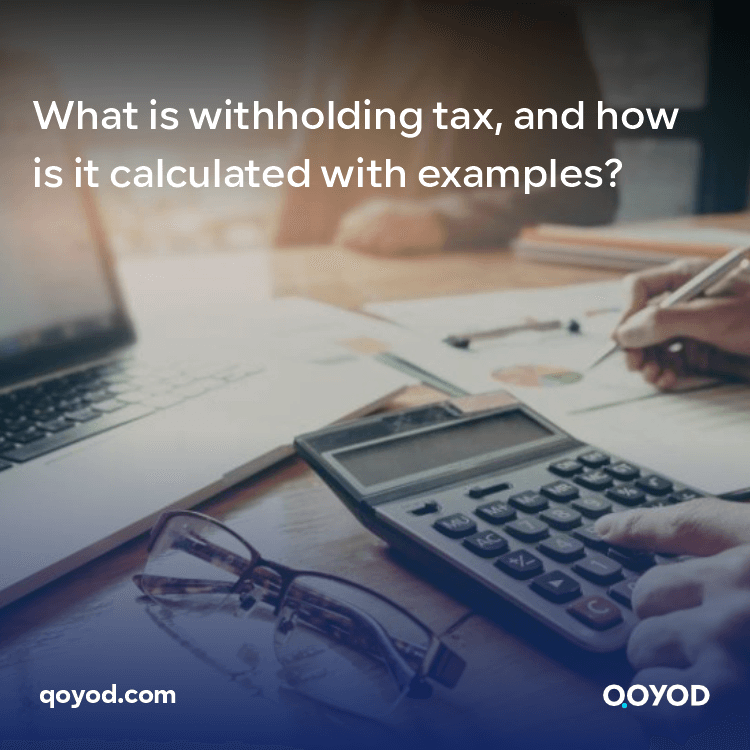There are different types of taxes imposed by countries on the trading of services and products in them, and the primary purpose of imposing taxes is to promote economic development and obtain periodic liquidity in the state’s financial coffers. The most important of these taxes is the withholding tax, which is imposed on services traded in different countries’ fields of trade and industry. In today’s article, we delve into the concept of withholding tax and how the Qoyod accounting system assists you in calculating it, understanding its worth, highlighting its relevance to your industry, and identifying the factors to consider when paying it to maximize your benefits. Despite falling under the tax category, withholding tax benefits both the buyer and the state. We will explain this in detail throughout the article.
What is a withholding tax?
Withholding tax refers to a small amount that is deducted from the price of the service you obtain from the seller and then paid to the Tax Authority. When you submit your tax return, the seller converts the amount into a discount notice. As a result, it reduces your income tax burden.
According to this definition, this type of tax is associated with the service, industrial, and commercial sectors. It also facilitates the organisation of tax collection processes, makes them more reliable and clear, and makes tax transactions smooth for the government. Note that the calculation of this tax takes into account the commercial discounts and other taxes imposed on you as a buyer, and it differs from the discounts offered by the merchant.
Why are withholding taxes imposed?
We conclude from the above that the return or goal of imposing this type of tax is not profitable. Rather, other goals benefit the country that receives these payments and also benefit suppliers, and these goals are as follows:
For the state
- Strengthening the financing of the state’s financial treasury and not limiting its resources to specific times or sources.
- Identify the people to whom we lend taxes and calculate the amounts they must pay to collect them.
- Reducing the emergence of the problem of tax evasion and completing commercial transactions under the auspices of state regulatory agencies.
- Organising the submission of tax returns and not leaving them at the disposal of one party to the commercial transaction alone is necessary to prevent fraud.
For taxpayer
When the taxpayer pays the tax, he receives a notice from the seller, and as he receives multiple notices, the amount of taxes imposed on the income decreases. If he is required to pay 1,000 riyals of income tax and has 200 riyals worth of deduction notices, he will only pay 800 riyals of the total income tax.
How is the withholding tax paid?
This tax is paid using an official document known as Form 41, the data of which is filled out and then submitted by the buyer or recipient of the service to the Tax Authority. He records its due values, provided that a new declaration is submitted every 3 months or quarterly, along with submitting the notices he obtained from merchants.
Some rules and procedures must be followed when paying the tax, including providing the taxpayer with an official receipt for the value due and paying the amounts in total on quarterly dates. This means that payment must be made at the end of April, July, October, and January of each year. The funds and reports are delivered to the General Tax Administration in cash, check, or postal mail.
Withholding tax rates
There is no fixed rate of withholding tax for all services. If the field is commercial, the rate of tax required to be paid will be different from the rate allocated to the consulting field, for example, and we explain this below:
- In the commercial field, 1% is deducted from the product’s final value, which means that if its price is 100 Saudi riyals, the tax due on it is one riyal.
- If you pay tax on an investment service, you must pay 3% of its total final value.
- The value of the tax is set at 5% in the consulting field, and the table below shows more details regarding the rates of withholding tax on some sectors in the country.
| sector | Tax rate |
| Purchases | 1% |
| Minerals and their products | 1% |
| Cooperative transportation | 1% |
| Quarry and mine extractives | 1% |
| Contracting and supplies | 1% |
| Industrial gases | 1% |
| Machines and their spare parts | 1% |
| Seedlings and flowers | 2% |
| Financial rewards for petroleum employees | 2% |
| Export support grant | 2% |
| Services | 3% |
| Rentals of all kinds | 3% |
| Brokerage agencies | 5% |
| Liberal professions (except doctors and lawyers) | 5% |
To whom does the withholding tax apply?
The system applies to any institution that provides commercial or industrial services identified by the Ministry of Finance, taking into account the following:
When the tax value is calculated, the value-added tax amount is not added first; rather, it is calculated on the net amount only.
Two taxes are not applied to the same product if one tax is larger than the other.
If there are discounts on the product, they are calculated when the value of the tax imposed on it is extracted.
The difference between withholding tax and advance tax payments
Many people do not know the difference between withholding tax and advance payments, but we simplify the differences between them in the following table:
| Comparison | Withholding tax | Advance payment tax |
| System type | Mandatory system. | Optional system. |
| Tax type | A tax based on deducting a percentage of income taxes. | The payer is exempt from paying withholding and addition tax. |
| Requirements to benefit from it | Discount notifications. | Deduct 40% of the last tax paid in advance. |
| Its specifications | It improves the state’s resources but faces difficulties with the multiplicity of suppliers. | The state grants periodic financial liquidity. |
The difference between value-added tax and withholding tax
Some differences between withholding taxes and value-added tax should be clarified to avoid confusion between them, which are:
| Comparison | Withholding tax | Value-added tax |
| Tax type | directly. | Indirect. |
| What is discounted? | Fundamentally based. | On the products. |
| On whom do you love? | Whoever pays the money in cash. | On the buyer. |
| When do you answer? | When paying in cash for a service or good. | In any case of sale. |
| Restrictions imposed on it | Without restrictions | It has restrictions. |
How to calculate withholding tax and submit a return
The tax rate is calculated on the value of services or goods stripped of any discounts or taxes, and after stripping them, the buyer adds the required withholding tax rate to the service according to its classification. Whether it is commercial, industrial, consulting, or other, he arrives at the amount of the tax imposed on him, then fills out return 41, which comes electronically, and then clicks Add, as shown in the following image:
| Tax period | Value | transaction date | Value |
| Tax year | Nature of the transaction | ||
| Tax registration number of the taxpayer | Total transaction value | ||
| Tax file numbers | Type of discount | ||
| Tax file number | Special payment system | ||
| National Identification Number | Net transaction value | ||
| Name of the taxpayer | Tax discount ratio | ||
| address taxpayer | Tax collector | ||
| The competent office | Currency type | ||
| Add | |||
A practical example of the application of withholding tax
A shipment of clothing was purchased for the Al-Zaini Fashion Foundation from Al-Manar Company. The price of the shipment was 15,500 riyals. Al-Manar Company granted the buyer a discount of 13%, with the following invoice issued:
| item | the number of pieces | Unit price | Product value |
| Women’s abaya | 50 | 30 riyals | 1500 riyals |
| Men’s thobes | 20 | 200 riyals | 4000 riyals |
| Pasht | 10 | 150 riyals | 1500 riyals |
| Men’s headband | 20 | 75 riyals | 1500 riyals |
| Daraa | 10 | 250 riyals | 2500 riyals |
| Shemagh | 15 | 300 riyals | 4500 riyals |
| The total is 15,500 thousand riyals. | |||
| The value of the trade discount is (15,500 ÷ 13) x 100 = 775 riyals. | |||
| Value-added tax: 14% = 2170 riyals. | |||
| Withholding tax and addition of 1% = 155 riyals. | |||
| Total paid = 15500 minus 775 = 14725 riyals. 14725 + 2170 = 16890 riyals. 16890 + 155 = 17050 riyals. | |||
Conclusion
The Ministry of Finance did not impose the withholding tax for profit or making money. Still, it was established to achieve benefits on two sides: the suppliers or beneficiaries of services and the state’s financial treasury. Therefore, withholding taxes were among the financial revenues allocated to directly alleviate the burdens on citizens and improve economic conditions simultaneously. To be able to calculate withholding taxes, subscribe to the Qoyod programme after a free trial of 14 days, during which you will be provided with the information and tools you need to be able to calculate the tax imposed on you and register it officially.
Join our inspiring community! Subscribe to our LinkedIn page and Twitter to be the first to know about the latest articles and updates. An opportunity for learning and development in the world of accounting and finance. Don’t miss out, join us today!




